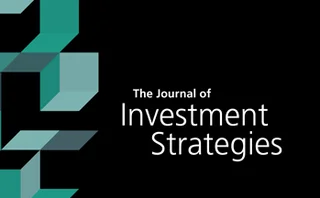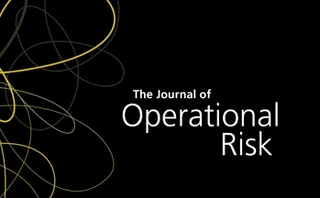Journals
Model risk tiering: an exploration of industry practices and principles
This paper seeks to shed light on one critical area of such frameworks: model risk tiering, or the rating of risk inherent in the use of individual models, which can benefit a firm’s resource allocation and overall risk management capabilities.
Credit portfolio stress testing using transition matrixes
In this paper, the authors propose a new methodology for modeling credit transition probability matrixes (TPMs) using macroeconomic factors.
Wrong-way risk of interest rate instruments
This paper investigates wrong-way risk effects on the pricing of counterparty credit risk for interest rate instruments.
A generic stress testing framework with related economic shocks and possible regulatory intervention
In this paper, the authors develop and demonstrate a universal framework for supervisory stress tests of financial institutions that considers the probable dependencies among macroeconomic shocks and possible regulatory intervention.
Skewed target range strategy for multiperiod portfolio optimization using a two-stage least squares Monte Carlo method
In this paper, the authors propose a novel investment strategy for portfolio optimization problems.
Sample dependence of risk premiums
This paper discusses the framework within which to study how sample dependence is transferred from the data to the premiums via the density.
Transaction cost analysis of digital innovation governance in the UK energy market
The latest online early paper in our special issue on blockchain enabled energy markets
Application of the Heath–Platen estimator in the Fong–Vasicek short rate model
In this paper, the authors construct a Heath-Platen-type Monte Carlo estimator that performs extraordinarily well compared with the crude Monte Carlo estimation.
Estimation of losses due to cyber risk for financial institutions
The objective of this paper is to analyze cyber risk from an operational risk perspective and to measure cyber risk empirically.
Validation of the backtesting process under the targeted review of internal models: practical recommendations for probability of default models
This paper provides practical recommendations for the validation of the backtesting process under the targeted review of internal models (TRIM).
In pursuit of good governance for the energy industry blockchain
This paper interprets the principles of good governance and corporate governance in the context of distributed ledger technologies, namely blockchain, analyzing specif- ically how these principles apply to a blockchain-enabled energy market.
A new approach to the quantification of model risk for practitioners
This paper's aim is twofold: to introduce a mathematical framework that is sufficiently general and sound to cover the main areas of model risk, and to illustrate how a practitioner can identify the relevant abstract concepts and put them to work.
Could holding multiple safe havens improve diversification in a portfolio? The extended skew-t vine copula approach
In this paper, the authors propose a vine copula model based on a bivariate extended skew-t distribution and derive its corresponding multivariate tail dependence function.
Loss given default estimation: a two-stage model with classification tree-based boosting and support vector logistic regression
In this paper, the authors using a data set composed of five Japanese regional banks, propose an loss given default estimation model using a two-stage model, classification tree-based boosting and support vector regression (SVR).
Calculate tail quantiles of compound distributions
In this paper the authors evaluate the performance of different approaches for estimating quantiles of compound distributions, which are widely used for risk quantification in the banking and insurance industries.
Efficient conservative second-order central-upwind schemes for option-pricing problems
In this paper, the authors propose improvements to the approach of Ramírez-Espinoza and Ehrhardt (2013) for option-pricing PDEs formulated in the conservative form.
Tail-risk mitigation with managed volatility strategies
This paper examines strategy performance from an investment practitioner perspective. Using long-term data from the Standard & Poor’s 500, the authors show that these strategies offer an improvement in risk-adjusted return compared with a buy-and-hold…
Does international stock index arbitrage exist?
This study investigates international stock index arbitrage opportunities between seven blue-chip indexes in Asian, European and US time zones over a twenty-year time horizon.
The extended SSVI volatility surface
This paper extends Gatheral and Jacquier’s surface stochastic volatility-inspired (SSVI) parameterization by making the correlation maturity dependent and obtaining the necessary and sufficient conditions for no calendar-spread arbitrage.
An optimized support vector machine intelligent technique using optimized feature selection methods: evidence from Chinese credit approval data
This paper focuses on feature selection methods for support vector machine (SVM) classifiers, checking their optimality by comparing them with some statistical and baseline methods.
Procyclicality and risk-based access: valuing the embedded credit default swap of employing bilateral credit limits in financial market infrastructures
In light of institutional knowledge, this paper presents the similarities between the survivor-pay component (Tranche 2) of the Canadian large-value transfer system (LVTS) and credit default swap (CDS) contracts.
The implicit constraints of Fundamental Review of the Trading Book profit-and-loss-attribution testing and a possible alternative framework
This paper presents the constraints embedded in the the profit-and-loss-attribution test and explores a possible alternative framework.
Introducing a novel system-of-systems axiomatic risk management technique for production systems
This paper focuses on conceptual and modeling frameworks in an attempt to explore qualitative and quantitative risk management techniques for hierarchical SoS risks, exemplifying the production systems for demonstration.
Maximum likelihood estimation error and operational value-at-risk stability
The aim of this paper is to systematically investigate the stability of operational value-at-risk (OpVaR) models when fitting heavy-tailed distributions to the relatively small sample sizes found in operational loss data.









